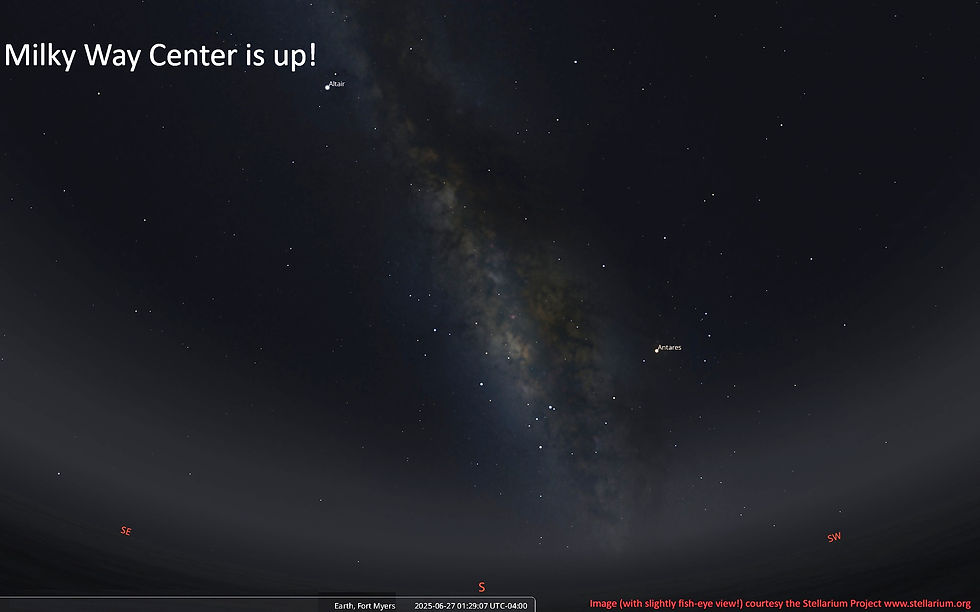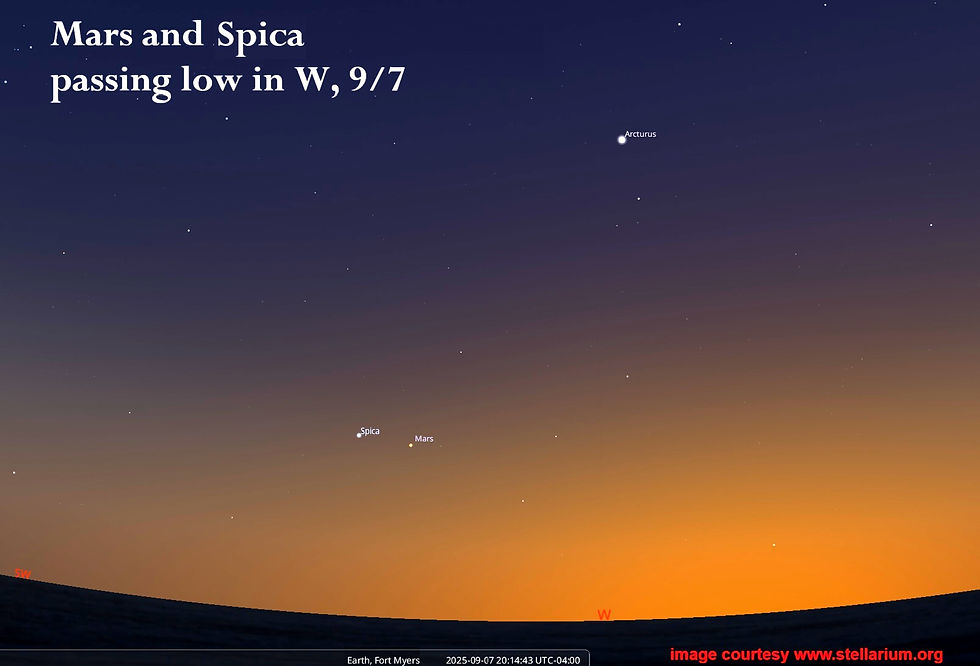What's Up in SW FL Skies: Summertime, and the Milky Way's Showing Off!
- heather92475
- Jun 12
- 6 min read
Updated: Jul 28

Moon Phases
June 2025 July 2025 August 2025
1Q Full 3Q New 1Q Full 3Q New 1Q Full 3Q New 1Q
2 11 18 25 2 10 17 24 1 9 16 23 31
Summer Solstice June 20th
August Meteor Shower: The Perseid meteor shower is one of the most famous, and it's the only sizeable summer meteor shower. This year the Perseids "peak" on August 12-13, but some will begin shooting through your northern sky from July 17th and there will be some Perseid activity right through August 23rd. The Perseid meteors originate in the debris trail of Comet 1090P Swift-Tuttle, and they happen every year at a similar date because Earth is crossing the orbit of Swift-Tuttle every year at that time. The broadness of the debris stream is the reason for the distribution of meteor sightings from July 17th through August 23rd, with a peak intensity in the "thickest" part of the stream, which we'll be crossing the nights of August 12th -13th. To view the Perseids, you will want to be looking north the night of August 12th, preferably after midnight, but at least after it's fully dark - and even then the full moon will be lighting up the southern sky, so only the brightest Perseids will be visible. As a bonus, however, check the color of these meteors when you do see one - I have found them to be slightly greenish, which is pretty interesting, especially compared to the slightly creamy color of the moon. This could be due both to magnesium in the chemical composition of comet Swift-Tuttle itself, but also of course due to the ionization of Oxygen as the little chunks of dusty grit pass so swiftly through Earth's atmosphere.
Planets: Sunset, Night and Dawn
Mercury is in the western evening sky at the beginning of June, reaching greatest eastern elongation – its furthest point from the Sun – on June 3-4, with Jupiter still above it in the early evening sky (and much farther up, Mars!). Just after sunset on June 7th, Jupiter and Mercury will be side-by-side just above the west-northwestern (WNW) horizon. Mercury is the one to the right, and not quite as bright as Jupiter! In the days following that, Jupiter will fade into the brightness closer and closer to the setting Sun. Around the middle of June, Mercury will look nicely bright in the post-sunset WNW sky, and as you watch night by night, Mercury, which started June as a fairly bright object but low to the WNW horizon after sunset, gradually will get higher and slightly dimmer and slightly farther south each evening - in a great slow arc! On June 26th, the waxing crescent Moon will be right beside Mercury in our early evening WNW sky. Then by mid July Mercury will have completed that southward evening arc and faded into the sunset brightness again (to re-emerge in August as a predawn planet).

Mars starts out high and bright above the WNW horizon in June, but by July 28th the whole "waxing crescent Moon passing a planet" scenario is playing out again above the W horizon after sunset - only this time, the Moon is beside Mars in our sky! And the same thing happens again in August, on the 28th, this time in the West-Southwestern sky, the waxing crescent moon passes a much lower Mars.

At the start of June, Jupiter was very bright just after sunset, with Mars high and bright above it and bright Mercury below it, but then as we move in our orbit the Sun comes between us and the largest planet, so Jupiter will, by mid-July, become a morning planet, appearing in the predawn sky below incredibly bright Venus. Extending that Jupiter-Venus line across the sky you will also notice Saturn as a late-night-to-predawn planet. Jupiter will get higher in the predawn sky as July turns into August, but Venus will of course be speeding along its orbit heading sunward, and so on August 11th and 12th your early-morning sky looking east will be pretty spectacular as the two planets (Venus to the right, Jupiter left) are as close to being in conjunction as they are going to get! Very bright and side-by-side in your predawn sky - Venus is the brighter one on the right, and 6 am to 6:30 am is the right time to be gazing Eastward for this stunning cosmic view.
Stars of Summer
In June, Castor and Pollux in Gemini will be setting shortly after sunset, and if you look northward, the Big Dipper (part of the constellation Ursa Major) will be in the "spills water" position. Looking higher and to the left (south and east) of them, you will see a tilted "backwards question mark" followed still higher and leftward again by a triangle - the backwards question mark is the mane and front paws of Leo the lion, the triangle his haunches. Each evening the same constellations will be about 1 degree closer to the western horizon at sunset (due to Earth moving just under 1 degree per day in our 365.25-day orbit), so Leo will be heading for the horizon by late July and lost in the sunset glare by late August. But there are so many more constellations to admire, "behind him" in a long arc from west to east!
Directly behind Leo is a huge constellation (Virgo) with one really bright star (Spica), but after Virgo, and not too high above our beautiful subtropical southern horizon, will be the two guardians of the galactic center of our home the Milky Way galaxy: Scorpius and Sagittarius. Antares (reddish in color) is the brightest star in the three-star crossbar of the "curly J" of Scorpius the scorpion, and eastward/upward from the curling tail is "the teapot" of Sagittarius, which is pouring tea onto the scorpion's tail! To admire these two, look at the first image in this blog post. Remember, the same stars reach the same positions in the sky 4 minutes earlier (because we keep time by where the Sun is in our sky, not by the stars) each night, so although the Milky Way and its guardians are up late in June, they get to the same places above our horizons earlier and earlier as the summer passes. Looking upward from Scorpius and Sagittarius, still along the arc of the Milky Way, but so bright that (unlike the Milky Way itself) you can see them from within city lighted skies are the three brilliant stars of the Summer Triangle.
Assuming you are already looking at Scorpius, now look 'waaaay up, see the brightest star practically overhead? That's Vega, brightest star of the summer skies, and the bright head of Orpheus as he plays his lyre in the compact constellation Lyra. To its left (eastward) is Deneb, the tail of Cygnus the swan, and below those two (to the southeast of them) is Altair, the bright eye of Aquila the eagle. So with Sagittarius, Scorpius, then the Summker Triangle above, you can keep track of where the Milky Way is in your night sky whether you can see it or not -- all of those stars are along the band of our galaxy.
Planetarium
Each day we are open, we show two different planetarium shows, and odd day shows are different from even-day shows, so there are four different shows each month, that alternate two-and-two. Special events are at our Events link, and daily schedule and show descriptions can be accessed by clicking on this link. On Sundays (the "Science Sundays" extra show), there's an additional "audience choice" show at 3:15, and typically on the First Sunday of each month we have a Sensory Sunday special show at 10:30 am, and most months we also have a Planetarium Premiere on the third Wednesday at 7 pm, so you have the potential to see ten different shows in the course of the month. The whole nature center, planetarium, butterfly aviary, raptor aviary and trails complex is open six days per week, closed Mondays. Often a staff member (Todd Sherman is our Planetarium Supervisor and does most shows on weekdays) or docent presenter will present live night sky talks along with our recorded shows: ask if you want a special one! Hoping to see you soon at the Center!
-- Heather Preston, Planetarium Director Emerita





Comments